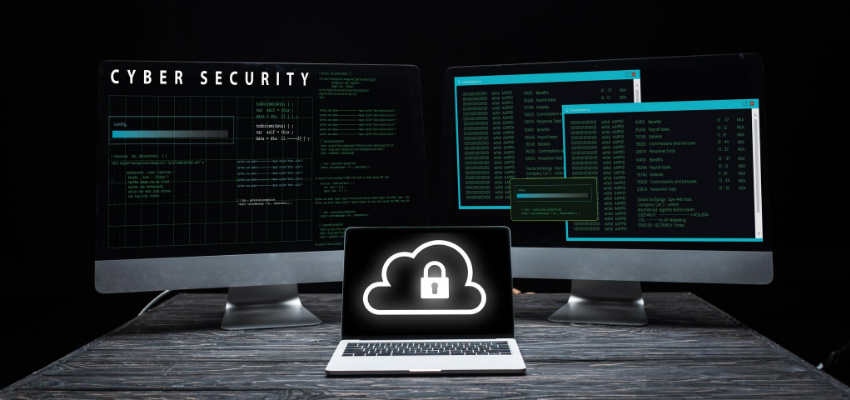Show:
Best Practices For Application Security In The Cloud
79% of companies have experienced at least one cloud security breach. Cloud-based applications are becoming increasingly popular and are almost avoidable if your company is using a hybrid or remote work model.

So, how do you keep your cloud applications secure?
Keep reading for an ultimate guide to the best practices for application security in the cloud, including how to assess your vulnerabilities, enforce strict password policies, learn what is zero trust security model, and improve cybersecurity health.
What Is Cloud Application Security?
Cloud application security refers to cybersecurity on an application level – the tools, technologies, and policies that secure cloud-based applications throughout their lifecycle. Many businesses have had increased concerns about moving to the cloud, and its security has always been a hot topic.
The pandemic forced many companies to invest in cloud applications, with many turning to SaaS (security as a service) companies to help securely facilitate remote work and collaboration. However, with the increased adoption of cloud-based applications, we saw a sudden spike in cyberattacks.
Cloud application security is essential in ensuring businesses transition to the cloud successfully, as a data breach could cause significant losses. Not only do data breaches cause financial losses, but they can cause legal issues when client data is revealed. The exposure of client data can harm the company’s reputation and affect the trust of your stakeholders.
So, cloud application security should be a top priority for businesses. In the rest of this guide, we will discuss the best practices for cloud application security to help companies protect their assets, data, and reputation when implementing cloud-based applications.
Best Practices For Cloud Application Security
Here are the best practices for cloud application security. Consider which of these practices would most benefit your existing strategies.
Perform A Risk Assessment & Regular System Testing
To best resolve vulnerabilities in your cloud applications, you must perform a risk assessment to identify these critical vulnerabilities.
You should establish an itemized list of every application in your system to ensure your security policies cover every cloud-based application. An inventory of all your cloud-based resources is integral to establishing good cloud-based security health.
You should also eliminate any cloud-based applications that are no longer relevant to your business practices or in use, as this will reduce the number of applications you need to provide cover for.
Your vulnerability assessments should continue throughout your use of the cloud-based application. You should perform regular system testing to reveal any new risks or threats that have developed and could affect your cloud security.
Once you have an itemized list of every cloud-based application, resource, and asset your company needs, you can begin to assess the risks associated with each application to understand your vulnerability to cyberattacks.

Establish Cloud Application Security Policies
To ensure your cloud-based resources are secure from all standpoints, you must ensure that your security policies are consistent across different applications. If you establish MFA for one cloud application, you must ensure that MFA is required to log into any other cloud-based application on your network. Consistency is vital, as you need to ensure there are no weak links in your cybersecurity strategy that a cybercriminal could take advantage of.
Enforce Strict Password Policies
Human error is one of the leading causes of data breaches. You need to ensure your employees are setting strong passwords and aren’t reusing old ones. You should educate your employees on what defines a strong and weak password. One of the best ways to enforce strict password policies is to implement password management software.
The software is a digital vault to ensure your employees remember their passwords. If your employees set weak passwords or reuse an old password, the software will notify them that their password is insufficient and advise them to change it. When a password is compromised, the software will send your employee an alert so that they can change the password and resolve the issue.
To ensure your passwords are inaccessible to a third party, password management software provides that only a single device can be used to access the account and offers MFA to secure the information. You can teach your employees to set strong passwords, but there is no guarantee that they will heed your advice. By using password management software, you can ensure good password health across your company.
Implement Threat Monitoring
To ensure your system is not exposed to a security threat, you need to monitor your security data for any abnormalities that could indicate a breach. Implementing AI for threat monitoring provides you with real-time updates and alerts based on security events, allowing you to always have intimate knowledge of your cloud security health. These alerts will allow you to respond quickly to security threats and put you in a better position to prevent security breaches.

Encryption
You need to encrypt your data when you store it in the cloud. When your data is encrypted, it is only accessible to those who possess the digital key to decipher the information. Data encryption makes your data unreadable to those who cannot decode it. If a third party accesses your data, it will be unreadable.
Zero Trust
When considering how to protect your cloud-based applications best, it’s essential to consider external and internal security threats. Many data security events come from employees, not just third parties and competitors. Just because your employees can access the cloud-based application does not mean that they should gain access to all of your sensitive data and company resources. Suppose an employee’s device is compromised or harboring malicious intent for the company. In that case, they could access all of the company’s sensitive data on the application, causing a security breach of colossal proportions.
The zero trust security model is a cybersecurity policy that helps you ensure your employees can only access the data they need to perform daily operations.
If their personal device is breached, or if they plan to steal sensitive company data, they will only be able to access a limited amount of information. Just because your employees can access your applications does not imply that you can trust them with your most valuable and sensitive digital assets.
Regular System Updates
To improve your cybersecurity health for cloud-based applications, you must perform software updates as soon as they appear. If your company is still running older versions of its applications and software, this could open you up to vulnerabilities that were eradicated by the latest update. Many companies make the error of using older versions, but it is not safe to do so and could compromise your cybersecurity health.
Summary
Moving to cloud-based applications to improve accessibility and collaboration when employees work from home comes with the need to focus on cloud application security. You need to understand the best cybersecurity practices to prevent a breach of your cloud-based applications. Keep these best practices in mind and compare them with your existing strategies to identify any vulnerabilities or improvements you need.

 Return to Previous Page
Return to Previous Page








